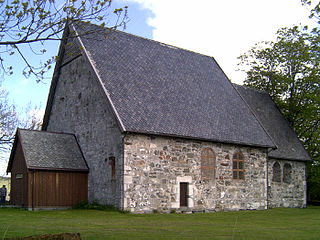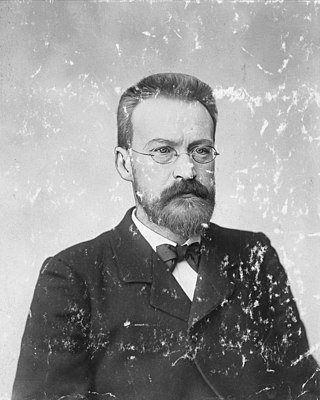
Gol is a municipality in Buskerud county, Norway. It is part of the traditional region of Hallingdal. The administrative center of the municipality is the village of Gol which is also the population center. Gol was established as a municipality on 1 January 1838. The area of Hemsedal was separated from Gol in 1897 to become a separate municipality. The municipality of Gol is bordered to the north by the municipality of Nord-Aurdal, to the east by Sør-Aurdal, to the south by Nes, and to the west by Ål and Hemsedal.

Romsdal is a traditional district in the Norwegian county Møre og Romsdal, located between Nordmøre and Sunnmøre. The district of Romsdal comprises Aukra, Fræna, Midsund, Molde, Nesset, Rauma, Sandøy, and Vestnes. It is named after the valley of Romsdalen, which covers part of Rauma.

Logtun Church is a historic, medieval parish church of the Church of Norway in Frosta municipality in Trøndelag county, Norway. It is located in the village of Logtun. It is one of the churches for the Frosta parish which is part of the Stiklestad prosti (deanery) in the Diocese of Nidaros. It is a museum and historic cultural site that was gifted from the parish to the Society for the Preservation of Ancient Norwegian Monuments. The stone church was built in a long church style during the late 12th century by an unknown architect. The church was the main church for the parish of Frosta until the new Frosta Church was built nearby in 1866. After that, the church was not regularly used. During the 1950s, the church was restored and it is now used infrequently as a wedding venue and it holds some summer worship services.

Nore Stave Church is a stave church located at Nore in Nore og Uvdal kommune in Buskerud county, Norway.

Gol Stave Church is a 12th century stave church originally from Gol in the traditional region of Hallingdal in Buskerud county, Norway. The reconstructed church is now a museum and is now located in the Norwegian Museum of Cultural History at Bygdøy in Oslo, Norway.

Kvernes Stave Church is a former parish church of the Church of Norway in Averøy Municipality in Møre og Romsdal county, Norway. The old church sits along the Kvernesfjorden in the village of Kvernes, just to the north of the Kvernes Church, the present church for the parish. The white, wooden church was built in a rectangular stave church style sometime during the first half of the 14th century. The church seats about 200 people.

Eilert Christian Brodtkorb Christie was a Norwegian architect.

Gabriel Adolf Gustafson was a Swedish-Norwegian archaeologist. He was responsible for the excavation and conservation of the Oseberg Ship (Osebergfunnet).

Haakon Shetelig was a Norwegian archaeologist, historian and museum director. He was a pioneer in archaeology known for his study of art from the Viking Age in Norway. He is most frequently associated with his work on the Oseberg ship (Osebergfunnet) near Tønsberg, Norway.

Nore is a village in the municipality of Nore og Uvdal in the county of Buskerud, Norway. It is located in the traditional region of Numedal.

Nicolay Nicolaysen was a Norwegian archaeologist and Norway's first state employed antiquarian. He is perhaps best known for his excavations of the ship burial at Gokstad in 1880.

Munkeby Abbey was a Cistercian monastery near the village of Okkenhaug in the municipality of Levanger in Trøndelag county, Norway. It was located about 5 kilometres (3.1 mi) east of the town of Levanger. The name "Munkeby" in Norwegian means Place of the Monks. It was closed during the Protestant Reformation. Today the former abbey is the sight of medieval ruins which are managed by the Society for the Preservation of Ancient Norwegian Monuments.

Munkeliv Abbey was a Benedictine abbey located at Nordnes in Bergen, Norway. It was one of the oldest monasteries in Norway, and also one of the wealthiest and best-documented. There are no visible remains today.
Anders Hagen was a Norwegian archaeologist. Hagen was most associated with the study of Norwegian archaeology and cultural heritage. He was a professor of Scandinavian Archaeology at University of Bergen and department head at the University Museum of Bergen.

The Altafjord is a fjord in Alta Municipality in Finnmark county, Norway. The 38-kilometre (24 mi) long fjord stretches from the town of Alta in the south to the islands of Stjernøya and Seiland. The 200-kilometre (120 mi) long river Altaelva empties into the fjord at the town of Alta. At Stjernøya and Seiland islands, the fjord splits into two straits before emptying into the Norwegian Sea. Some of the larger side-branches off the main fjord include Langfjorden, Kåfjorden, and Korsfjorden.

Harry Fett was a Norwegian art historian and factory owner. He headed the Norwegian Directorate for Cultural Heritage from 1913 to 1946.

Anton Wilhelm Brøgger was a Norwegian archaeologist and politician.

Arne Nygård-Nilssen was a Norwegian art historian, publicist and magazine editor.
Alf Bøe was a Norwegian art historian, educator, curator and author.

Hustad Church is a preserved former parish church of the Church of Norway in Inderøy municipality in Trøndelag county, Norway. It is located just north of the village of Gangstadhaugen. It is the former main church for the Sandvollan parish which is part of the Stiklestad prosti (deanery) in the Diocese of Nidaros. The white Romanesque, stone church was built in a long church style around the year 1150. The church seats about 150 people. In 1887, the new Heggstad Church replaced this church. At that time, this church was closed and sold to the Society for the Preservation of Ancient Norwegian Monuments to be maintained as a museum. The church is no longer regularly used, but it is used for special occasions.

















